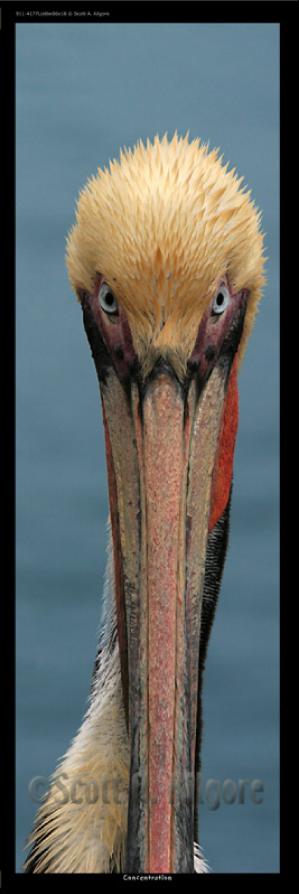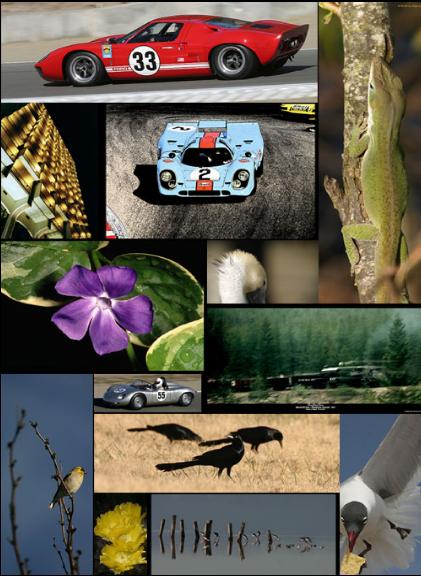 |
|
LOG ON |
|||||||||||||||
Scott Kilgore Photography Nature, Wildlife, Auto Racing, Train, Railroad Photography, Fine Art Photography |
||
"Concentration" |
||
 |
Concentration 911-4177 6x18 .............................. $32.00 911-4177 12x36 ........................... $155.00 12" x 36" Canvas Stretched, gallery wrapped over solid wood stretcher frame..........................$250.00 |
||||||
The fate of the American Brown Pelican is a testament to the success of effective environmental conservation laws. Nearing extinction in the 1960-1970's due to DDT, the species has made a slow but strong comeback after the banning of the chemical in 1972. While populations in Florida have been declining during the past decade, populations in Louisiana and Texas have recovered to pre-pesticide levels. The brown pelican poplulation died out in Louisiana in 1963, which is rather disturbing and ironic since it is the Louisiana state bird. The birds vitually disappeared from the upper Texas coast, with only 18 breeding pairs recorded in 1975. It should be noted that the decline in brown pelicans started well before the introduction of DDT in the 1940's. In Texas, the birds were regularly killed by fisherman, who mistakenly believed the pelicans competed with them for food. This resulted in an 80% decline between 1920 and 1954. West coast populations were also severely threatened, though not virtually extinct like the Eastern brown pelican. Given only a few more years of use of DDT, the species would have been extinct throughout the United States. While populations have generally recovered to pre-DDT levels, they are nowhere near historic levels in the 1800's. Also, there are not as many pelicans around as one might think if you were to see them at Galveston or Port Aransas. Brown pelicans are used to being around humans and places where humans fish. You may see the same group of pelicans cruising the shorelines several times a day, and think you are seeing many more. Yet if you travel more remote areas away from human activity, you will also see very few brown pelicans. Brown pelicans are still threatened as a species. |
|||||||
Our brown pelican is the smallest of the world's pelicans. With a weight of over 8 pounds and with a wingspan of up to 7 feet, this is still a very large bird. Docile in nature, they are generally not particularly fearful of humans. Some immature birds are even quite friendly, a naive trait that usually disappears after contact with some of the lower quality individuals of our species. I am particularly fond of pelicans. It is the highlight of a day in Port Aransas when I can find a pelican who I recognize (they don't all look the same), and either sit down next to him and watch the sun set, or the ships go by, or have him fly up and land right beside me. I knew one that would stay next to me on a railing whenever I came to visit. This probably had a lot to do with the fact that I would tell other people to leave him alone. People would see us so close and want to pet him. I would tell them "no, he'll bite". I'm sure he appreciated the protection. He could go to sleep on a railing near me and know that no one would bother him, at least as long as I was there. I started calling him Buddy. Further down the page is a picture of him as a young pelican. This special relationship went on for two years until nature had more interesting activities for Buddy than sitting on a railing with a human friend. The last time few times he landed on the railing and came up to me, he only stayed for a short time. I have seen him since, but he mostly ignores me, and sitting on the railing. And that's the way it should be. As photo subjects I find that they can be elegant, or humorous, graceful, or goofy. And always entertaining. Scott A. Kilgore |
|||||||
Please contact me for prices on canvas prints. Canvas prints are available on all images in sizes from 12x24" to over 12 feet. Also note that if you would like updates of new releases, please Email me to receive Emails displaying new works. Note that for copyright issues and cluttering up the site, I rarely add anything to this site. This site shows examples of my work. It is not a display of ALL of my work. |
||
To Go To Information Page On Framing And Matting Of Our Prints Click Here |
||
 |
||
For best results in viewing the images on this site, you should at least be able to see a contrast difference in the graph above from A to Z. If nessasary, adjusting the brightness and contrast on your monitor should provide reasonable results. IMPORTANT NOTE LCD Monitors I have noticed many inexpensive LCD monitors today have been advertising how bright they are. This may be great for some uses, but these are terrible for viewing graphic arts print work. Most are way too bright. and their advertised contrast ratios are, at best, optimistic. Advertised contrast ratios over 800/1 on any LCD monitor should be considered suspect. There are No blown out whites in the images on this site. If you do not see detail in the bright color or white areas of the pictures, your monitor is too bright. Unfortunately, I have tested several LCD monitors from various manufacturers recently (2007) that are so bright that they are too bright on lighter colors and whites, resulting in all detail appearing washed (or blown) out. Sadly, this is even after calibration with a color meter. Or maybe I should say attempted calibration since when the monitor cannot be dimmed to black with pure white on the screen, it usually will not calibrate properly. Likewise, many images may have darker backgrounds in printing than may show up on your monitor. I rarely had these problems on CRT monitors, even really cheap ones. CALIBRATION Calibration with a color meter such as the Pantone Colorvision Spyder is recommended if you are really interested in color accuracy. Having said that, it is not really nessasary for viewing photography and other graphic arts on the web. Your colors almost certainly won't match, but unless you are going to compare a print to the screen, the colors should still be pleasing. If you have never used a calibrated monitor, you will probably find it a bit weird and unnatural at first. The screen will probably look dim and yellowish. But that is only because you have gotten used to looking at monitors that are factory set with more of a blue cast. After a while, the uncalibrated monitor will start to look as unnatural as it really is. Monitor calibration is very important to individuals preparing work for press printing and other printing processes. Therefore, I use a calibrated graphics CRT and a calibrated LCD for preparing all the masters for print work. Both of these were moderately expensive monitors. For the web, I use an inexpensive old 17" CRT that is set on the default factory settings so I see what most of the world sees. |
||
Why I Don't Like The Web For Displaying High Resolution Art Simply, on the web you are looking at graphics with a maximum resolution of 72 dots per inch (dpi). Since human vision can generally distinguish detail down to about 300 dpi, most lithographic and digital printing processes print at 300 dpi, though some can print as tight as 600 dpi. Fandancer, the heron shown above, for example, makes a stunning 24 x 30 inch print (7200x9000 pixels). But as far as I'm concerned, you cannot tell that from that from the image above. I could have taken that with a 2 mp point and shoot camera and gotten better results for the web. Better, yes, better. Downsizing large images for the web tends to make highly detailed images lose detail, and can even, on certain images make them actually look softer. Conversely, an small image with low, even soft detail can look extremely sharp on the web, or as a small print, but enlarge it, and it will look soft. To at least give the viewer a chance to see some of the detail of the prints, I have included enlarged inset images on some pages. But they are still only 72 dpi. |
||
Wholesale Customer and Fundraising Organizations Please Take A Look At Our Please Email Us for Special Prices and Ordering Requirements Custom and Special Ordered Products Are Available That are Not Shown |
||
 |
 |
 |
||||
This Site and All Contents Copyright © Scott A. Kilgore This is not a source of free images |
||
This Site Under Construction For Information |
||
 |
||
Website Notes: 2-2015 - Updating Contact Information, finally adding Canvas prints and Dye sublimination aluminum metal prints to site. Canvas hadbeenavailable through galleries since late 2007. 11-11-07 A Major Update of about 50 new ly added images in several galleries. All of the initial galleries are now open!!! Flowers expanded to two pages Burr Clover, another garlic chive, flame acanthus (hummingbird bush), lilies, and Turk's Caps added. Auto Racing, Oil and Gas Industry, Raptors, and Trains and Railroad Galleries are now open. A few autumn scenes were added for the fall in a new Fall Colors Gallery. The wildlife (mammals) gallery is now open. The Auto Racing Galleries are (so far) divided into three sections, Vintage Sports and Sports Racing Cars, Vintage Formula Cars, and Dirt Track, Modified, and Stock Cars Galleries. The Oil and Gas Industry Gallery is called "The Oil Patch" and is located in the Scenic Views Gallery. Very wet Cardinals were added in the Cardinals Gallery in the Songbirds Gallery. A Yawning Gull (Open Wide) was added to the Gulls and Terns Gallery. A wood duck portrait was added in waterfowl. A gecko and a bullfrog were added in the reptiles gallery. (Is anybody out there interested in 'gators?) A peaceful harbor scene with sailboats and snowy egrets was added in the Atmosphere Gallery, which is a part of the Scenic Views Gallery And a take on a curious parking situation is presented in the Statements Gallery with "Free Parking - Western Style" Absolutely Stunning Painted Buntings added to Songbirds Gallery v1ExtendedWPSc2oct. 8-20-07 Roseate Spoonbill Chasing Great Egret added in Spoonbill page of Other Wading Birds - - v1ExtendedWPSc1.freeway 8-8-07 Scenic and Abstract Gallery Added - including: It All Goes By In A Blur -- Atmospheric Scenic Views -- The Oil Patch --Making A Statement! -- also, Cardinals Gallery Wing added in Songbirds Gallery - v1ExtendedWPS.freeway - minor revision on 8-9-07 to Panoramic page adding links in pictures. 8-3-07 Panoramic Page and Framing and Matting Information Pages added - v1ExtendedWP.freeway Major update 7-22-07 Master title - Scott Kilgore Photo v1GLardehbpwsGB1CFHSW.freeway All bird and other wildlife galleries up (though not complete) except: Raptors -- Cardinals in Songbirds -- Autos and Auto Racing -- scenics -- art pieces -- sunsets -- railroads -- |
||